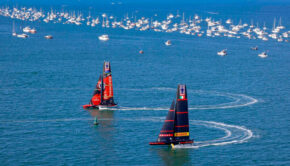Flying Into Wind On Foils Could Tip Balance
Published on August 19th, 2013
By Paul Lewis, The New Zealand Herald
It could be a game-breaker. Oracle Team USA showed off their ability to foil upwind on Saturday as skipper Jimmy Spithill taunted Team New Zealand for “running away”. Perhaps the most riveting aspect of Saturday’s America’s Cup action on the water, it did not come in the Louis Vuitton Cup final but earlier.
The two Oracle boats, one skippered by Sir Ben Ainslie and the other, Boat 2, by Spithill, continued their jousting on the race course ahead of the Emirates Team New Zealand-Luna Rossa clash. As they did so, Spithill’s boat – the one most believe will contest the Cup match – got up high on its foils and sailed fast upwind, remaining on the foils for an extended period.
It was an impressive display.
Spithill did not mince words when asked what he had drawn from that experience and when he and Team NZ chanced upon each other and went at it on an unofficial downwind run on Sunday, before Team NZ broke off and headed for Alcatraz. On the latter, he said: “It was pretty tough [to draw any conclusions]. Every time we get near them, they just run away. So it’s hard to read too much into it.”
However, it could be a different matter regarding foiling upwind. Foiling – the art of reducing drag vastly by lifting the 72-foot hulls out of the water on their foils – has long been regarded as the key to the 34th America’s Cup.
Team NZ have been the frontrunner so far, being the first to foil and having the longest time on the water to perfect their foiling techniques and speed; they have also produced the fastest and most consistent foiling gybes so far.
Saturday, however, Oracle showed that they have foiling abilities upwind. So too do Team NZ, but it is arguable whether the Kiwis can pull it off as consistently and for as extended a period as the United States syndicate managed yesterday.
Before their electronic and hydraulic problems, Team NZ also seemed very quick upwind, outpacing the Italian yacht on the upwind leg. They did so not by getting up high on the foils but by lifting the hulls so they just skim the choppy wave surface – “half-foiling”, some call it.
There is only one upwind leg on the five-leg course for the Cup. But it takes only about 30 minutes to sail the course and the upwind leg takes more than 30 per cent of that time. So the ability to foil upwind could be a major boost.
There are still some doubts about the merits of upwind foiling. Opinion is split on whether it is as much of a benefit as it seems. Foiling upwind takes the boat too far off course – going faster but covering more ground. The key is in finding the right balance between speed and the shortest course to the mark.
The Italians, for example, regularly covered between one and two miles extra in round-robin races against Team NZ, an obvious disadvantage in a yacht race, because of the Kiwis’ command in finding the best balance between speed and direction.
Spithill said: “I wouldn’t be surprised to see it [upwind foiling] happening in the Cup. We are working on it and the Kiwis are obviously working on it as well. Today wasn’t perfect conditions [for foiling upwind], you’d want to be at the upper end of the course, with flat water and a good wind and maybe a flood tide [an incoming tide] but we were happy with what we did.”
A bullish Spithill also said Oracle were not pulling their punches in their training races against each other. “We are pushing as hard as we can. It’s hard not to be at full throttle in these boats. That’s what we need. “We go at it hard, we really push each other. Why wouldn’t you? It’s Ben Ainslie and the guy is the best sailor in the world.
“It’s a massive thing for us. Look at the challenger racing. It’s a bit different. We are two competitive teams in two competitive boats; I don’t think that is happening in the challenger racing. You can’t afford to be weak in any one area and we are able to practise starts and all that.
“I think it [having two boats] is our trump card. We have hired a lot of good sailors, we have two good boats and two competitive race teams and we race each other as hard as we can.”
Oracle’s in-house racing was the second time the syndicate had made telemetry data available to challengers in return for racing on the course. Spithill said that too was about getting battle-ready.
“We just thought it would be good to have the teams under pressure of the cameras and in race mode. We also thought it would be good for the sport and for the spectators.” Story








 We’ll keep your information safe.
We’ll keep your information safe.